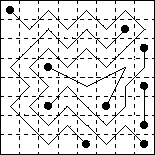|
|
Solution: If the position looks rather familiar at first sight, look closer at the bishops; they are all on light squares. The number of final positions is 17 and they are reached on Black's 12th move. The main point to watch in the enumeration is that an 18th position with BQc4, BSd7, BSg6, WBb5, WKf1, WSe2, WSf3 cannot be reached since Pe2-e4 cannot be delayed long enough to allow Qh4-c4.
Comments: This was published as part of an article on “The Professor's Christmas Party”. It will be noticed from the dates on other problems that most fairy compositions of around this time were published during the festive season, when orthodox conventions were expected to be broken a little. Problems 10, 184, 270, 275-288, 497-499 are also in this ‘synthetic games’ class.
 The British Chess Problem Society
The British Chess Problem Society
